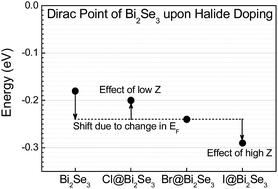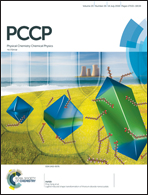Bi2Se3 topological insulator at the 2D-limit: role of halide-doping on Dirac point†
Abstract
2D topological insulators exhibit insulating bulk and conducting edge states with a Dirac point, which at times is within the energy gap and could be on either side of the Fermi energy. In this study, we demonstrate a method to tune the energy of the Dirac edge state by introducing halides as dopants in Bi2Se3. We chose halides to substitute the anion, so that due to higher atomic number (of iodine, for example) with respect to selenium, the spin–orbit coupling parameter could be enhanced, leading to the significant separation of the Dirac point from the Fermi energy. With different halogens having different atomic numbers on either side of selenium, the Dirac point could hence be tuned towards both directions. The dopants, due to their heterovalent nature with respect to selenide, introduce carriers in the lattice and consequently, also shift the Fermi energy. We show that the Dirac point with respect to Fermi energy could be correlated to the dopant's atomic number and thus the atomic-number-induced spin–orbit coupling parameter. Strains developed in the lattice due to a mismatch in the effective ionic radii of the dopants and the host anion affected distribution of band energies, leaving the (distribution of) Dirac point unaffected due to its topologically protected nature.



 Please wait while we load your content...
Please wait while we load your content...